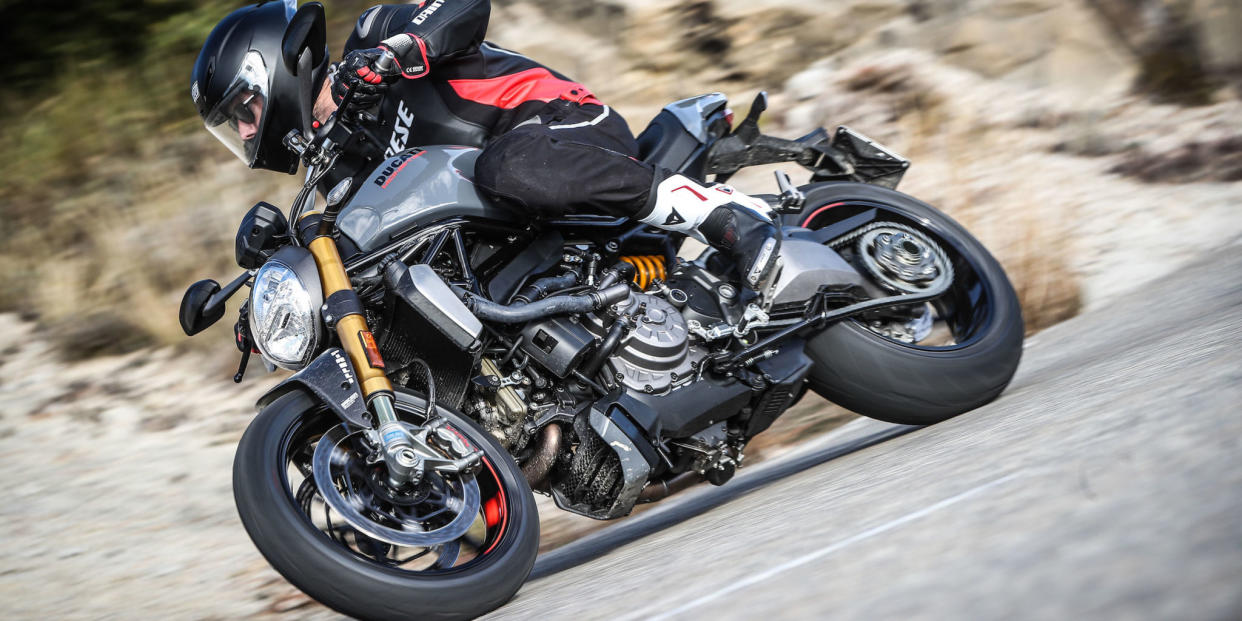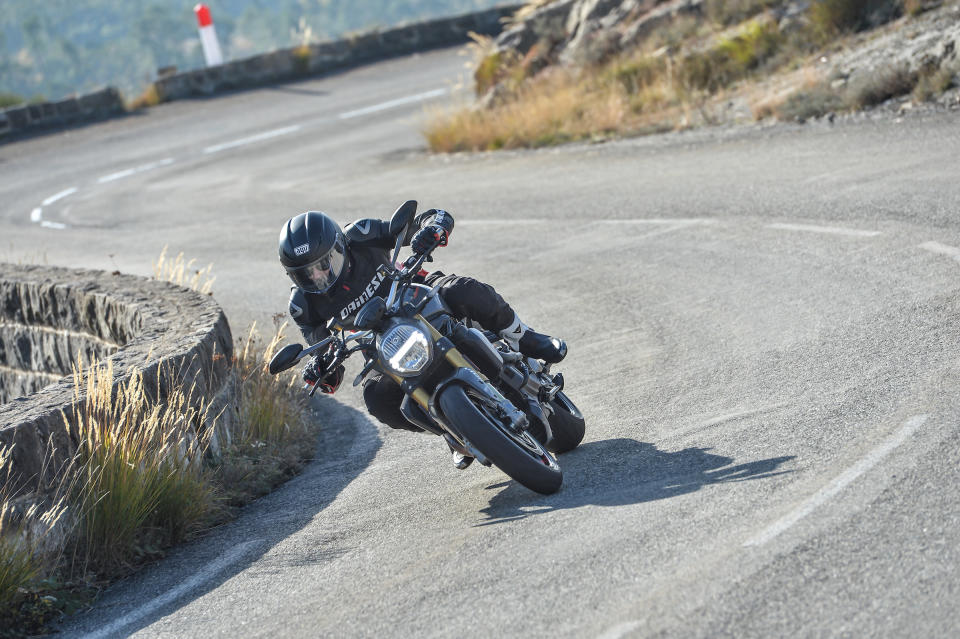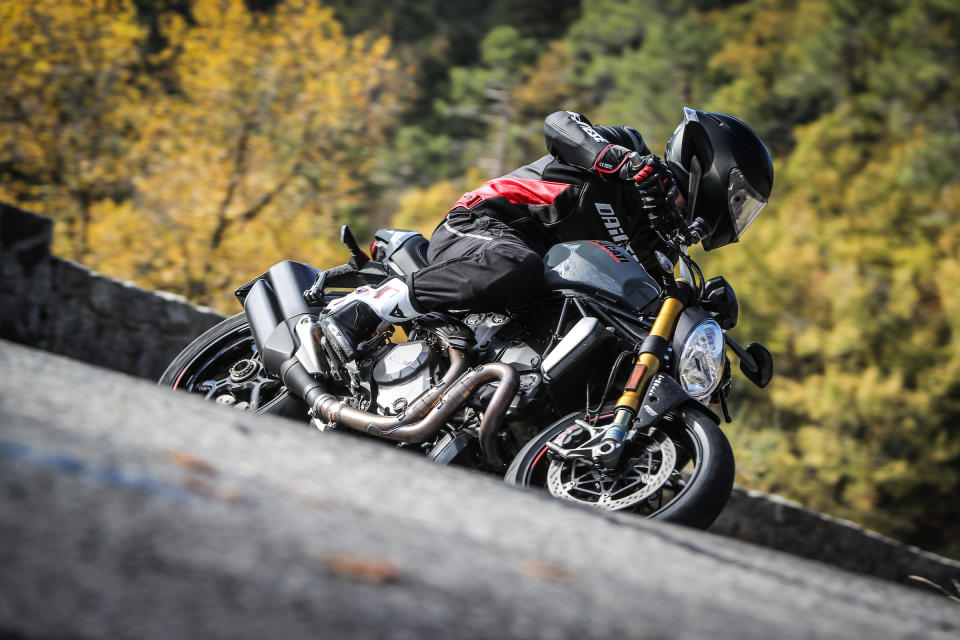The 2017 Ducati Monster Is All the Street Bike You Need—And None of What You Don't

The first Ducati Monster was a parts-bin special. Twenty-four years ago, Ducati hung a 900-cc air-cooled V-twin from the 888, added a circle headlight at one end and a teardrop tail at the other, and put that now-iconic tank in between. It wasn't the fastest thing on the block, but it was the coolest. Even people who otherwise took no notice of motorcycles fell in love with the mean, minimalist Monster.
Ducati's engineers have had two decades to improve on the original design, and it shows. Though the latest model bears a striking resemblance to the O.G. '93 bike-particularly if the two are not viewed side-by-side-the new Monster is a different animal, packed with power and modern technology. Even compared to the outgoing version, which debuted in 2014, the 2017 Monster 1200 is practically all-new. Everything except the front trellis subframe has been changed to make the bike slimmer and more stylish and to improve the handling and performance.
We recently spent a day exploring the mountain roads around Monaco on the S version, which has a fully-adjustable Ohlins fork and shock as well as Brembo M50 calipers that bite 330 mm discs (the standard model has 320mm discs, Brembo M4-32 calipers, a Kayaba fork, and a Sachs shock). The S also comes with different wheels and a quick-shifter. The wheelbase is 1 inch shorter than the outgoing model, which livens up the steering and makes pulling wheelies that much easier.

This is the first Monster to be fitted with Bosch's excellent Inertial Measurement Unit (IMU), which is the brains behind the fabled Cornering-ABS. It also powers the rest of the Motorcycle Stability Control suite. The bike has traction control, wheelie control, Cornering-ABS, and rear-wheel lift control.
[contentlinks align="center" textonly="false" numbered="false" headline="Related%20Story" customtitles="The%2010%20Best%20Buys%20in%20Motorcycles%20for%202017" customimages="" content="gallery.2309"]
When choosing a bike with an IMU, it's essential to check whether the systems are individually adjustable and whether they reset every time you restart the bike. In this case, the settings are not reset every time, and it's possible to adjust each system independently, which allows the rider to focus on one skill at a time, and perhaps more importantly, to adjust the bike to road conditions.
In a particularly twisty section of our ride, there were frequent wet patches, so I set the traction control to "1" and the wheelie control to "0" (both on a scale of 0-8). On one wet corner, the traction control caught a slide as I accelerated away from the apex, then the front wheel rose into the air as the bike gained traction on a dry part of the road.
It was brilliant. And it wouldn't have been possible with old, non-IMU traction control systems, which used ABS wheel-speed sensors to compare the front and rear wheel speeds. In that case, a wheelie and a slide look the same, so traction control and wheelie control cannot be adjusted or turned off independently. Even if you're not pushing the limits, Cornering-ABS is great to have during mid-corner panic stops. Bosch's literature states that "67 percent of all accidents in Germany that are caused by two-wheelers and occur in curves could be positively influenced by MSC," and we're inclined to believe them.
Make no mistake, this is a very sporty bike with top-notch components. Just few years ago, its performance would have been on par with world-class sport bikes.

Slide the starter switch down to fire up the engine, and you'll be struck by how small the bike feels. When looking straight ahead, the bright TFT display is barely visible at the bottom of your field of vision. Add in the classic Ducati torque and the smooth clutch take up, and there's little to distract from the task of blasting toward the horizon. The 150-hp, 1200cc V-Twin has 15 more horses than the old standard Monster, and it's controlled by a ride-by-wire throttle. There are three riding modes-with varying power and throttle response-and Ducati has managed to eliminate the low-speed snatch of the outgoing model's engine. The wide seat is comfortable, and the upright bars put the rider in a good position for aggressive riding and leaning.
The Ohlins suspension did an excellent job controlling the bike's movement over choppy road surfaces and under heavy braking, even though we left the damping settings alone. We didn't, however, have a chance to compare it to the suspension on the base model. The M50 calipers made high speed stops a one-finger affair (they're the best-performing brakes available, so no complaints in that department.)
The "S" model is also the first Monster with a quickshifter, and it enables smooth, quick upshifts with the throttle wide open. Unlike most other quickshifters out there, this one also rev-matches downshifts. It's interesting technology, but part of the fun of riding a motorcycle is using the clutch and blipping the throttle on downshifts. On a racebike, quickshifters are useful, but on a sport naked, they're more of a functional curiosity than a necessity.
The original 90's Monster was slower, but riding it was like taming a wild animal. It was very clearly a Ducati with an air-cooled engine and the trademark tambourine jingle of the dry clutch. It took a while to warm up, had barely any steering lock, and the long first gear required careful modulation of the clutch. In brief, it was a demanding but rewarding ride.
From the saddle, the new model is objectively better in every way. Nowadays, however, there are many more competitors. Riders looking for 150+ bhp naked bikes with an IMU can choose between the Monster, KTM's Super Duke R, Aprilia's Tuono, and the BMW S1000R. It's important to remember-especially among this absurdly powerful category of bikes-that bigger numbers don't always mean more enjoyment. Prospective buyers should test-ride as many of the above bikes as they can. Sure, the other bikes might be more demanding and offer a more extreme ride, but the new Monster is like the old in in at least one way: It's not the fastest bike around, but it is still the coolest.
Valve-adjustment intervals have been lengthened to 18,000 miles. The rider's seat height is adjustable, and a removable passenger seat cover is included. The base Monster 1200 is available in red for $14,695. The 1200S is available in red for $16,995, or gray for $17,195.
You Might Also Like

